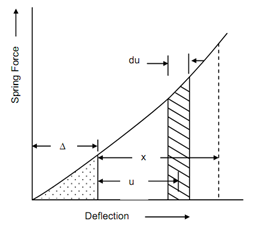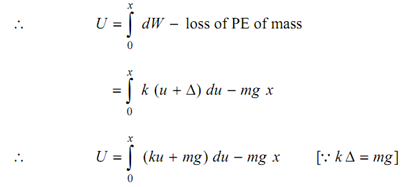Energy Method:
This method is applicable to the conservative systems only. In conservative systems entire energy remains constant. While a mechanical system is in motion, the entire energy of the system is partially kinetic and partially potential (elastic strain energy). The kinetic energy is because of the velocity (x ) and mass (m) and potential energy is because of spring stiffness and relative movement among the two ends of the spring.
Energy (E) = T + U = constant (C)
here T = Kinetic energy of the system,
U = Elastic strain energy.
As total energy remains constant
∴ dE /dt= 0 or d/dt (T + U ) = 0
T =( 1/2 ) m (x')

Figure 4
The potential energy of the system has two following points:
(i) loss/gain in PE of mass, and
(ii) strain energy of spring.
Let an infinitesimal element du at x = u.
From Figure 4
Spring force (Fu ) = k (u + Δ)
Work done dW = k (u + Δ) × du

or U = ½ (kx2 ) + mg x - mg x
or U = ½ kx2 . . . (5)

∴ (½ m × 2 x' × x' ) +( ½ k × 2x )+ x'= 0
or mx'+ kx = 0
This is the similar equation as we obtained earlier.